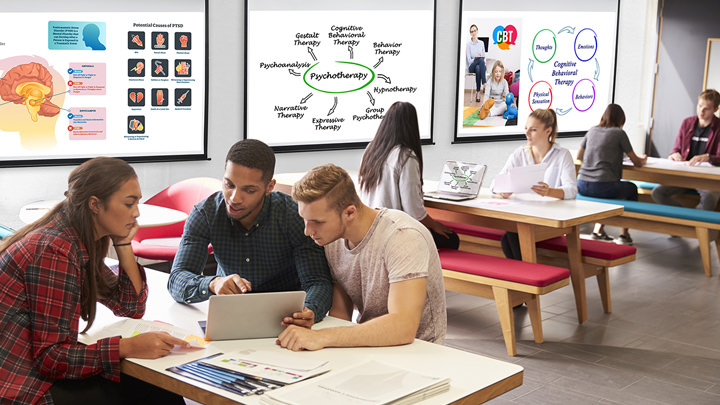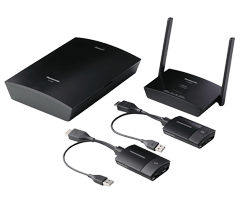
What is a Collaborative Classroom?
A collaborative classroom refers to a learning environment aimed to enhance one another’s learning effects by working on assignments together as a group. By actively cooperating with other students in the group or educators, it offers many benefits to students such as improving their academic performance level, driving their desire to learn and increase their sense of responsibility.
Learning to Learn, Teach and Enhance One Another
The Johnson brothers (D.W. Johnson and R.T. Johnson), the leading authorities on the research of collaborative learning, define collaborative learning as follows. “Collaborative learning is the instructional use of small groups so that students work together to maximize their own and each other's learning.”

By having students split in small groups and talk and teach one another about their assignments instead of the traditional learning method of one-sidedly listening to a lecturer standing in front of a podium offers the advantage of being able to obtain higher educational effects.
In collaborative classrooms where collaborative learning is carried out, technology such as tablet terminals, smartphones and laptops are often used. By properly using these devices, discussions can be encouraged, your sense of participation in the class can be improved, you can acquire even more knowledge and your communication skills can be improved.
Also, due to the novel coronavirus pandemic, nowadays it is difficult for students and teachers to actually see each other face to face or gather together with multiple people, and the collaborative learning styles are changing in various ways.
Five Elements that Make Collaborative Learning Function
Collaborative learning is not just about giving assignments to small groups. According to D.W. Johnson, the following five basic components must be met in order to make collaborative learning function properly.
Positive Interdependence
Group members must understand that your own work is useful for their peers and that the work of their peers is useful for you. To do so, assignments must be prepared that they can work on together. Even when evaluating grades, it is effective to incorporate a mechanism to add the contributions between peers.
Face-to-Face Promotive Interaction
Collaborative interactions will promote understanding and learning, and enables a wide range of simultaneous learning. Therefore, it is necessary to set a learning scene where ample interactions can be exchanged. It is desirable that the composition of small groups have different characteristics such as ability and that the number of people who can talk face-to-face is about four to six people.
Individual Accountability/Personal Responsibility
You must not create a situation that leaves learning to others. Enable students to recognize that individuals are responsible for their own learning and responsible for the learning of each of their peers.
Interpersonal And Small-Group Skills
Students can have the skills to communicate accurately, to know, trust, accept and support each other and have the skills to resolve conflicts constructively.
It is necessary to create this kind of learning experience.
Group Processing
In order to look back on group activities and pursue better methods, members will evaluate each other after each activity. This will serve as an opportunity to rediscover the significance of collaborations and foster a positive attitude towards collaborating.
Advantages of a Collaborative Classroom
In a collaborative classroom, you can see scenes that are very different from conventional classes. Instead of opening up a textbook and one-sidedly listening to a teacher, active learning is developed with a group.
These advantages are introduced below.

Encourage Discussions
Collaborative learning is designed to increase lively discussions within the group. Exchanging diverse opinions with a group can lead to obtaining various information and increases the possibility of leading to a better solution.
Also, you can connect perspectives and facts that you didn't have before, deepen your thoughts by discovering relationships and differences and make it easier to obtain conceptualized knowledge.
If there are digital tools, it will also be possible to interact with students from overseas online.
Create a Habit of Looking Back
At the end of each class, set aside time to look back on how the assignment should have been tackled and how you could have supported your peers. By looking back on the support you provided, you will be able to be aware of the skills you have acquired through the class.
Visualize Your Thinking Process
By projecting deliverables of yourself and other members onto a large screen in a classroom, students can discuss about each other’s thought processes.
Also, by looking back at the steps taken to solve the problem and discussing, learning can be further deepened.
Preparations to Start a Collaborative Classroom
We have listed the matters to keep in mind when starting a collaborative classroom. If you start without a plan, it will end with just dividing the students into groups. The teachers must properly understand its significance and the necessary steps before making an annual plan and working on it.

Convey the Significance of Collaborative Learning
When starting a collaborative classroom, you can create an atmosphere where students will want to participate by conveying its significance. Convey the following and share awareness that a collaborative classroom is meaningful.
- Collaborating will make learning even more fun.
- Collaborating will enable deeper learning and lead to better understanding.
- The social skills obtained through collaborating are essential for accomplishing something with others in the future.
Establishing Rules within the Group
If you decide the rules of the group from the beginning, it will support worthwhile learning. It is good to discuss within the group, establish the following rules and post them somewhere inside the classroom.
- “When someone else is talking, I will listen to what that person is saying.”
- “Instead of doing what others are doing on behalf of them, I will help that person.”
- “When I need help, I will ask for it.”
- “Even if you criticize people's ideas, don’t criticize those who are expressing their thoughts.”
Teach the Skills to Ask Good Questions
In class, create questions about a given topic and write each question on the board. Decide on the most pressing and interesting questions from them and discuss the characteristics of the questions with the students.
Explain that the "good questions" that often give the best answers are thoughtful and sometimes bold, and that they don't make the respondent feel as if they are being asked a question.
Teach how to negotiate
Members who talk often and loudly are given many opportunities to speak, but that alone will not convince the other members.
Skilled negotiators listen carefully to what the other person is saying, show patience and flexibility and expand on discussions based on shared ideas and group agreements. After sharing these characteristics with the students, conduct a consensus building simulation about future research themes.
Have Teachers Acquire Facilitation Skills
In the collaborative classrooms, there is less direct guidance from teachers and more promotions of learning experiences with the entire class or with small groups. In order to create a highly cooperative classroom, teachers must simulate and learn how to frequently listen, paraphrase, ask clever questions and negotiate.
Acquire the Ability to Learn in a Group
By jointly conducting high-dimensional learning by selecting and combining information from multiple documents or analyzing scientific data, you can reach a higher level. Aim to create a classroom where members can feel the joy and sense of accomplishment together.
Creating an Environment for a Collaborative Classroom
Carrying out discussions with your peers is the key to a collaborative classroom. In order to make this effective, it is good to think about how to arrange desks and maintain a proper distance. When arranging digital devices or a display for presentations for a discussion, it is necessary to consider their visibility.
Grouping
Rather than forming a group with only close members, creating a group comprised of diverse members will enable them to touch on various ideas and increase the effects of collaborative learning. Four to six people are suitable for small groups, and beyond that, it becomes difficult to gather opinions. With four people, split them up into groups of two, and with six people, split them up into groups of three to also tackle small assignments.
Think about the Layout of the Classroom
If you form an island in a circle with the members of the group, it will become easier to carry out discussions. Therefore, it is desirable to prepare desks and chairs that are easy to move, as well as a classroom with sufficient space.
Consider the Spacing for Each Group
It is important to keep a reasonable distance between the island of each group so as not to interfere with the discussions.
Arrange the AV Equipment
The introduction of appropriate AV equipment is essential for facilitating discussions. Preparing displays and projectors where students can share their achievements with each other as well as a wireless connection environment to enable easy access to the equipment is important.

Display
By installing a display where members can share the screen, it will make discussions with the entire class even more effective. Also, by having overseas students, students from other universities or students studying from home participate in the discussions online, the display can be used for collaborative classes with new educational styles from recent years. By arranging a small display for each group and actively using them, it will help activate the discussions.
Also, with a touch screen display where you can point to things while explaining them, it will make it easier for listeners to understand and it will make it easier for the person explaining to convey explanation side to communicate their intentions.
Projector
Introducing a projector is also effective. By projecting onto a large screen, it is easy to see even from far away, and it offers the advantages of ensuring social distancing and being able to project course materials onto any wall of the classroom. By selecting a model that can be installed not only vertically but also can be rotated to either a horizontal or diagonal 360-degree angle, you can project beautiful images in any situation without compromising image quality.
Presentation Tools
For university students, smartphones, tablet terminals and PCs are devices that are indispensable for submitting reports and conducting research.
When giving presentations in class, issues often occur if these devices do not display smoothly onto a display or screen.
These issues can be solved with a presentation system that can wirelessly display the presenter’s materials. This is a system that you want to consider for smooth operation of classes and research presentations.
Improve the Environment for Wi-Fi Communication and Digital Devices
With the acceleration of ICT in educational sites, the number of cases where AV managers are placed in universities is increasing. An AV manager is someone who has expertise in information and communication equipment and audio/visual equipment and is in charge of installing and maintain necessary equipment and supervising how they are used while working with teachers and the school. The role of an AV manager will become even greater in the future.
Developing a Wi-Fi Environment
Develop a Wi-Fi environment depending on the number of students and staff who will use it and the types and usage methods of digital devices.
Currently, there are endless incidents such as cyberattacks, malware infection caused by phishing and leakage of personal information and confidential information, so strict security measures are required in universities. AV managers should be involved in educating students about password management and cyber risks.
Concrete Examples of Various Learning Spaces

Active Learning Classroom
The use of active learning is expanding as a stage for collaborative learning. They are spaces that enable flexible operation that are complete with digital equipment and desks and chairs can be arranged freely.
Informal Learning Space
There are many cases where open spaces such as a library or lounge are used as informal learning spaces for the purpose of inviting people from outside the university and holding small events or used as casual learning spaces.
Makerspace/Hackerspace
The makerspace (hackerspace) is a laboratory-like space with tools such as 3D printers, laser cutters and machine tools for students who wish to make things to learn and create with a group.
It is a space where new ideas can be produced together with your peers, teachers and mentors in an open area without having to be confined in a laboratory.
There are cases, such as at Sinclair College, where specialized study spaces and laboratories were introduced that reflect the environments where students work after graduation.
Dedicated Study Space
There are many cases where university graduates or scholars belonging to other universities or educational research institutes are allowed to use university libraries or dedicated study spaces.
Building a Learning Environment with Creativity And Flexibility
In today’s educational sites, creating an open and flexible environment and encouraging communication between teachers and students and among fellow students are emphasized, and the restructuring of learning environments is moving forward to realize them. These learning environments are said to be the “third teacher” for students followed by parents and educators. Building learning environments filled with creativity and flexibility is required to share assignments between students and teachers, facilitate collaborations and improve communication.






